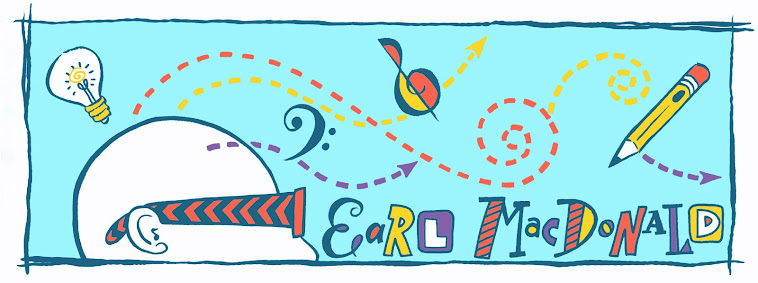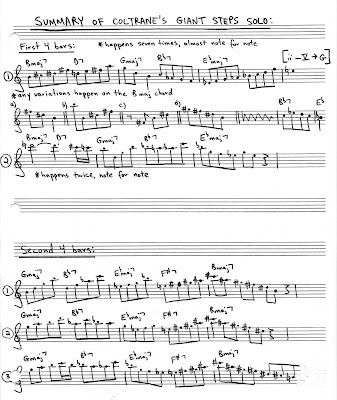Surprised is how I would describe my reaction when analyzing John Coltrane's solos from the "Coltrane's Sound" recording of October, 1960. I had assumed Coltrane would be playing obvious, identifiable patterns through the matrix portion of his tunes, as he did on the Giant Steps recording from May, 1959. I was wrong. In the time between these two recordings his playing underwent a noticeable evolution, which lead to his being able to play in a much free-er, more melodic manner, with considerably less repetition.
I transcribed "Giant Steps" years ago, and made the following summary page. Notice how he played the first four measures almost note-for-note SEVEN TIMES! This explains why I made the aforementioned assumption. [Click on the image to make it larger and more legible.]
Many of the questions I posed before transcribing 26-2 are now moot. There are some really pretty lines, some of which I may deliberately copy. The first four measures of choruses one and two are examples. I marvel at how the descending whole tone scale perfectly matches the progression to outline the chords.
I am beginning to think that the opening four measures of the 26-2 solo is perhaps a key to unlocking the mystery of the progression and how to play over it.
Tomorrow, in addition to doing some more transcribing, I think I'll write out a page of half note chord-tone/guide-tone lines which weave through Coltrane changes. Maybe...just maybe... embellishing around these fencepost guide tones might be an easier, less rigid, and more effective approach to playing these tunes. We'll see. Ever up and onwards.
I transcribed "Giant Steps" years ago, and made the following summary page. Notice how he played the first four measures almost note-for-note SEVEN TIMES! This explains why I made the aforementioned assumption. [Click on the image to make it larger and more legible.]
Many of the questions I posed before transcribing 26-2 are now moot. There are some really pretty lines, some of which I may deliberately copy. The first four measures of choruses one and two are examples. I marvel at how the descending whole tone scale perfectly matches the progression to outline the chords.
I am beginning to think that the opening four measures of the 26-2 solo is perhaps a key to unlocking the mystery of the progression and how to play over it.
Tomorrow, in addition to doing some more transcribing, I think I'll write out a page of half note chord-tone/guide-tone lines which weave through Coltrane changes. Maybe...just maybe... embellishing around these fencepost guide tones might be an easier, less rigid, and more effective approach to playing these tunes. We'll see. Ever up and onwards.



I enjoy you blog! Keep up the good work. Maybe you'd be interested in seeing my diss?
ReplyDeletehttp://scholarlyrepository.miami.edu/oa_dissertations/332/
Rodney
Thanks Rodney. Your dissertation is truly impressive. I know many trombonists who will think this is pure gold. Thanks for sharing the url. Congrats, Doc.
Delete